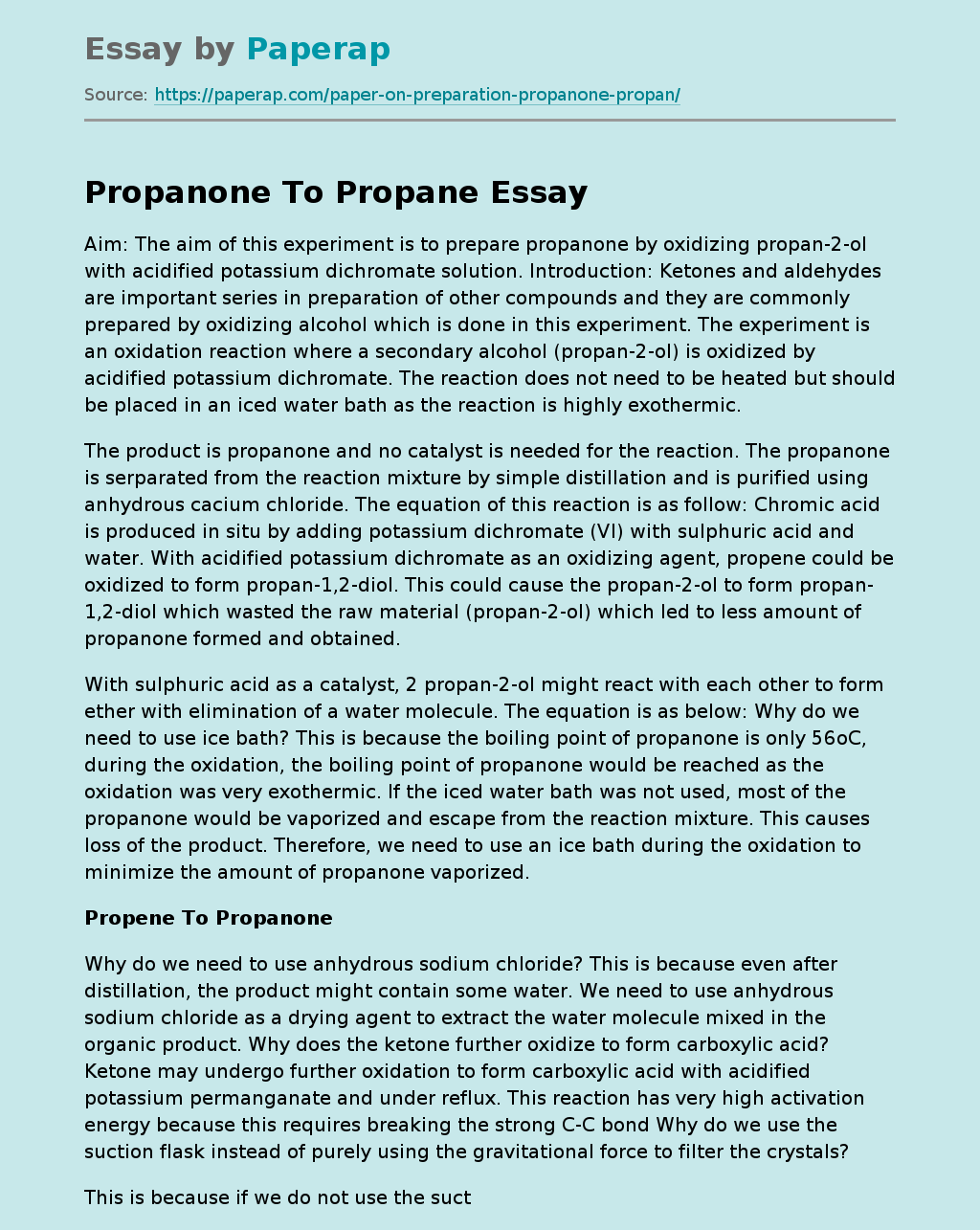Propanone To Propane
Aim: The aim of this experiment is to prepare propanone by oxidizing propan-2-ol with acidified potassium dichromate solution. Introduction: Ketones and aldehydes are important series in preparation of other compounds and they are commonly prepared by oxidizing alcohol which is done in this experiment. The experiment is an oxidation reaction where a secondary alcohol (propan-2-ol) is oxidized by acidified potassium dichromate. The reaction does not need to be heated but should be placed in an iced water bath as the reaction is highly exothermic.
The product is propanone and no catalyst is needed for the reaction. The propanone is serparated from the reaction mixture by simple distillation and is purified using anhydrous cacium chloride. The equation of this reaction is as follow: Chromic acid is produced in situ by adding potassium dichromate (VI) with sulphuric acid and water. With acidified potassium dichromate as an oxidizing agent, propene could be oxidized to form propan-1,2-diol. This could cause the propan-2-ol to form propan-1,2-diol which wasted the raw material (propan-2-ol) which led to less amount of propanone formed and obtained.
With sulphuric acid as a catalyst, 2 propan-2-ol might react with each other to form ether with elimination of a water molecule. The equation is as below: Why do we need to use ice bath? This is because the boiling point of propanone is only 56oC, during the oxidation, the boiling point of propanone would be reached as the oxidation was very exothermic. If the iced water bath was not used, most of the propanone would be vaporized and escape from the reaction mixture.
This causes loss of the product. Therefore, we need to use an ice bath during the oxidation to minimize the amount of propanone vaporized.
Propene To Propanone
Why do we need to use anhydrous sodium chloride? This is because even after distillation, the product might contain some water. We need to use anhydrous sodium chloride as a drying agent to extract the water molecule mixed in the organic product. Why does the ketone further oxidize to form carboxylic acid? Ketone may undergo further oxidation to form carboxylic acid with acidified potassium permanganate and under reflux. This reaction has very high activation energy because this requires breaking the strong C-C bond Why do we use the suction flask instead of purely using the gravitational force to filter the crystals?
This is because if we do not use the suction flask or any negative pressure, the filtration process will be too slow. The suction flask provides a negative pressure and together with the gravitational force, the filtration will be much faster. The crystal and the filter paper can also be air dried quickly. A picture of a suction flask The filter paper is placed on the plate, and the filter paper is moistened with a solvent to prevent initial leakage. The liquid to be filtered is poured into the cylinder and drawn through the perforated plate by vacuum suction.
In our experiment, we use running tap water to produce a suction force. Actually, there are many more methods to produce the negative pressure, such as lowering the pressure using a vacuum pump. The main advantage in using this type of filtration is that it proceeds much more quickly (several orders of magnitude) than simply allowing the solvent to drain through the filter medium via the force of gravity. Ketones and aldehydes Ketones are versatile compounds which can be converted to a number of useful functional groups through reduction, nucleophilic addition or condensation reactions.
Ketones and aldehydes are important series in preparation of other compounds and they are commonly prepared by oxidizing alcohol which is done in this experiment. Ketone also plays a very important part in organic synthesis. Ketones and aldehydes can be synthesised into many other chemicals. Reactions involving ketones include nucleophilic addition reactions to the carbon-oxygen double bond to form an -OH group in the compound with the addition of a nucleophilic group. Testing carbonyl compound There are lots of ways to test the existence of C=O in an organic compound.
Propanone To Propane. (2019, Dec 05). Retrieved from https://paperap.com/paper-on-preparation-propanone-propan/

